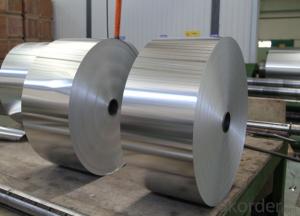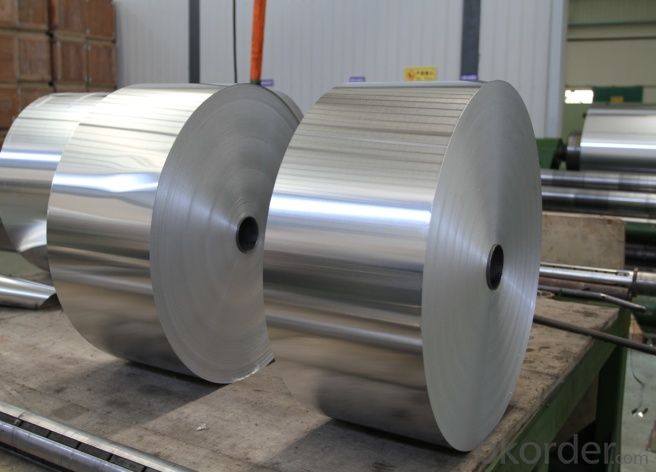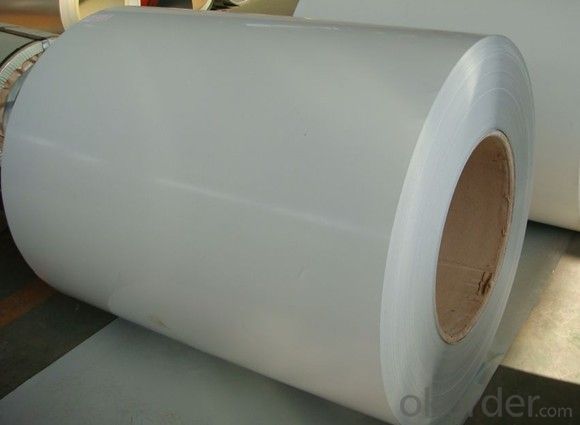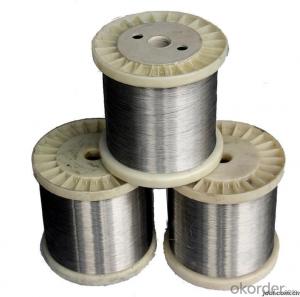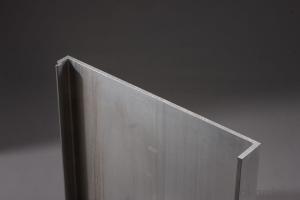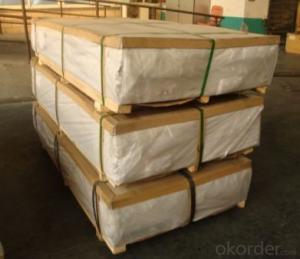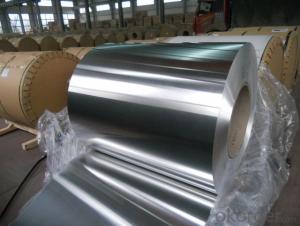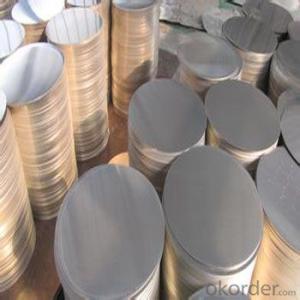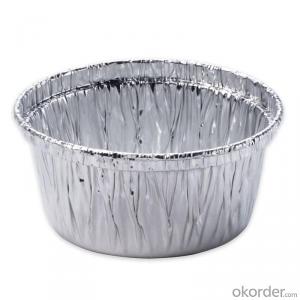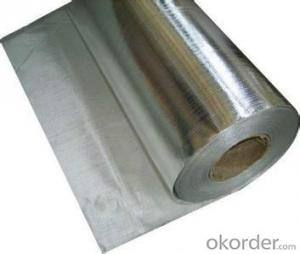Beveled Aluminum Skin Sheets - 8011 1235 3105 Aluminum Foil in Roll
- Loading Port:
- Shanghai
- Payment Terms:
- TT OR LC
- Min Order Qty:
- 5 m.t.
- Supply Capability:
- 9000 m.t./month
OKorder Service Pledge
OKorder Financial Service
You Might Also Like
Specification
Introduction of Aluminum Foil
Aluminum foil is aluminum prepared in thin metal leaves with a thickness less than 0.2 millimetres (8 mils); thinner gauges down to 6 micrometres (0.24 mil) are also commonly used. In the United States, foils are commonly gauged in thousandths of an inch or mils. Standard household foil is typically 0.016 mm (0.63 mil) thick, and heavy duty household foil is typically 0.024 mm (0.94 mil). The foil is pliable, and can be readily bent or wrapped around objects. Thin foils are fragile and are sometimes lamilated to other materials such as plastics or paper to make them more useful. Aluminum foil supplanted tin foil in the mid 20th century.
Annual production of aluminum foil was approximately 216,000 tonnes (216,000 tons) in LingFeng (our company) one year..Approximately 75% of aluminium foil is used for packaging of foods. household foil,container foil, cosmetics and pharmaceutcal foil etc, and 25% used for industrial applications (e.g. thermal insulation, cables and electronics).
Application of Aluminum Foil:Mainly used in package for food, drinking, cigarette, Pharmaceutical, photograph, daily necessities, power capacitor, construction, auto,boat, celling, lable, etc .
Quality of Aluminum Foil: Totally free from defects like white rust, oil patches, roll marks, edge damage, camber, dents, holes, break lines, scratches and free from coil set.
Chinese Standard of Aluminum Foil: ASTM-B209. EN573-1, GB/T3880.1-2006
Packing for Aluminum Foil: Seaworthy wooden case/box, or as your requirement. ID of aluminum foil roll: 76mm,152mm,200mm,300mm
Kind attention: Specifications can be customized as the customer’s requirements.
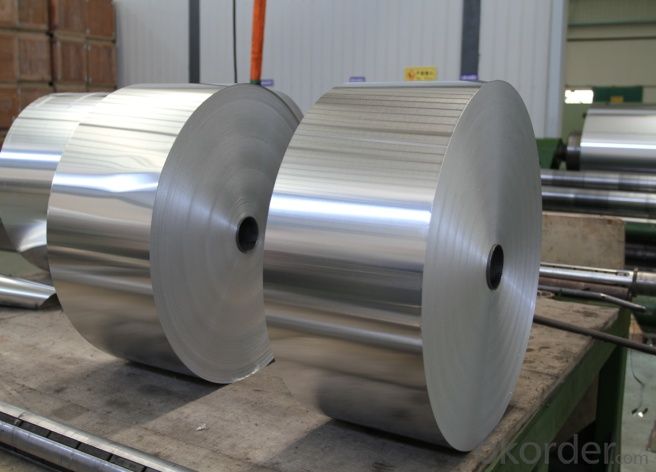
Specification of Aluminum Foil
| Alloy No. | Thickness (mm) | Width (mm) | Temper | |
| A1145,A1235,A8011 Household Foil | 0.005-0.2 | 20-1700 | O,H14,H18,H19,H24 | |
| A3003,A8011 Semi Rigid Container Foil | 0.005-0.2 | 20-1700 | O,H14,H18,H19,H24 | |
| A8011,A8021 Pharmaceutical Foil | 0.005-0.2 | 20-1700 | O,H14,H18,H19,H24 | |
| A8011 Foil Label | 0.005-0.2 | 20-1700 | O,H14,H18,H19,H24 | |
| A1145,A1100,A1235,A8001 Fexible Packing Foil | 0.005-0.2 | 20-1700 | O,H14,H18,H19,H24 | |

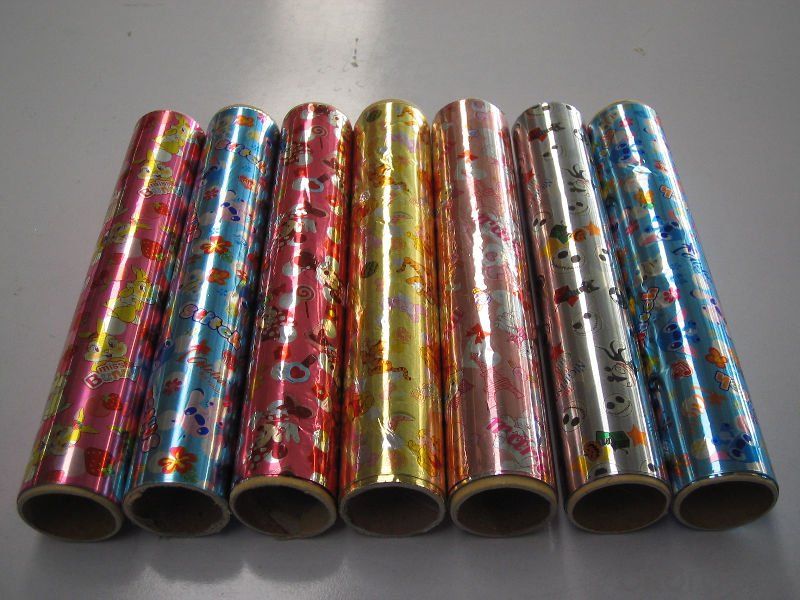
- Q: Is it possible to recycle aluminum sheets multiple times?
- <p>Yes, aluminum sheets can be recycled again and again. The recycling process for aluminum is highly efficient, and it can be recycled indefinitely without losing any quality. This is due to the fact that aluminum retains its properties even after multiple recycling cycles. Each time aluminum is recycled, it can be melted down and reformed into new products, making it a sustainable and environmentally friendly material.</p>
- Q: How is aluminum sheet made?
- Aluminum sheet undergoes a rolling process to be manufactured, known as rolling. This process entails passing a preheated aluminum ingot through a succession of rolling mills. The initial step involves heating the ingot to a specific temperature to enhance its malleability. Once heated, the ingot is then fed through a sequence of rolling mills, wherein it is continuously pressed and stretched to reduce its thickness and increase its length. The rolling mills consist of a pair of rotating cylinders with grooves on their surfaces. As the ingot passes through these cylinders, it undergoes compression and elongation, resulting in a thinner and longer sheet. This process is repeated multiple times, with each pass further reducing the sheet's thickness. To maintain the desired thickness and dimensions, the sheet is periodically subjected to annealing. This process involves heating the sheet to a specific temperature and gradually cooling it. Annealing helps alleviate internal stresses and ensures the sheet retains its desired properties. Once the desired thickness is achieved, the aluminum sheet is cooled, trimmed, and either cut into specific lengths or rolled into coils for further processing or distribution. The final product is a flat, thin, and versatile sheet of aluminum that finds applications in various industries, including construction, automotive, packaging, and electrical appliances.
- Q: I am doing a project on Aluminum it has 13 protons just to make sure everyones on the same page. How much of it is left or exsits? Also how does it behave?
- As Vincent noted, aluminium is an abundant element in the earth's crust. It occurs in all clay minerals. Its main ore, bauxite(a mixture of aluminium hydroxides) is still available in vast deposits; particularly in Australia and South America. Aluminium is a reactive element, and so is not found in nature in the elemental form. Aluminium is a metal, and an amphoteric substance; that is; it reacts with both acids and bases.
- Q: What is the weight of an aluminum sheet?
- The weight of an aluminum sheet can vary depending on its dimensions and thickness. Aluminum is a lightweight material, so sheets made from it generally have a relatively low weight compared to other metals. To determine the weight of an aluminum sheet, you would need to know the length, width, and thickness of the sheet. By multiplying the dimensions and the density of aluminum (2.7 g/cm³ or 0.0975 lb/in³), you can calculate the approximate weight of the sheet.
- Q: Is aluminum sheet fire-resistant?
- No, aluminum sheet is not inherently fire-resistant. However, it does have a relatively high melting point and can conduct heat well, which can help slow down the spread of fire.
- Q: Can aluminum sheet be used for heat exchangers?
- Yes, aluminum sheet can be used for heat exchangers. Aluminum has excellent thermal conductivity and is lightweight, making it a suitable material for transferring heat efficiently in heat exchangers. Its corrosion resistance and durability also make it a popular choice in various heat exchange applications.
- Q: I need to fix some connections at my dad's house. The original wiring is aluminum, but the newer stuff he did is copper. Simple wire nuts will not suffice. Already had one melted one. I need to fix the connections, but need an economical, safe way of doing it. Suggestions?
- You need both anti-oxide paste, (follow directions), and spring type connectors to take care of the thermal creep.- A good electrical supply hose will have them. Give them the details and they'll advise you. (Last I heard, modern wirenuts are ' UL listed' for the application. Lack of the surface treatment is probaly the cause of your bad connection.) Aluminum wiring isn't bad by itself. It's the terminations that cause the problems. Bad advice Shabir - Screw connectors have no 'spring' to take up the thermal cycles of the aluminum and are exactly the WRONG thing to use for the problem in question.
- Q: What is the flexural modulus of aluminum sheets?
- The flexural modulus of aluminum sheets refers to the measure of stiffness or rigidity of the material when subjected to bending. It quantifies how much the material will deform or bend under a given load. The flexural modulus of aluminum sheets typically ranges between 70 and 79 GPa (Gigapascals).
- Q: Are aluminum sheets suitable for outdoor signage?
- Yes, aluminum sheets are suitable for outdoor signage. They are durable, weather-resistant, and can withstand various environmental conditions such as rain, wind, and sunlight. Additionally, aluminum sheets can be easily customized, making them ideal for outdoor signage applications.
- Q: What is the cost of an aluminum sheet?
- The cost of an aluminum sheet can vary depending on several factors such as the thickness, size, grade, and market conditions. Generally, aluminum sheets are priced per square foot or per pound. On average, the cost can range from $0.50 to $5 per square foot or $1 to $10 per pound. It is important to note that these prices are just estimates and can fluctuate based on supply and demand, location, and other factors. To get an accurate cost, it is recommended to contact local suppliers or check online marketplaces for the most up-to-date pricing information.
Send your message to us
Beveled Aluminum Skin Sheets - 8011 1235 3105 Aluminum Foil in Roll
- Loading Port:
- Shanghai
- Payment Terms:
- TT OR LC
- Min Order Qty:
- 5 m.t.
- Supply Capability:
- 9000 m.t./month
OKorder Service Pledge
OKorder Financial Service
Similar products
Hot products
Hot Searches
Related keywords
